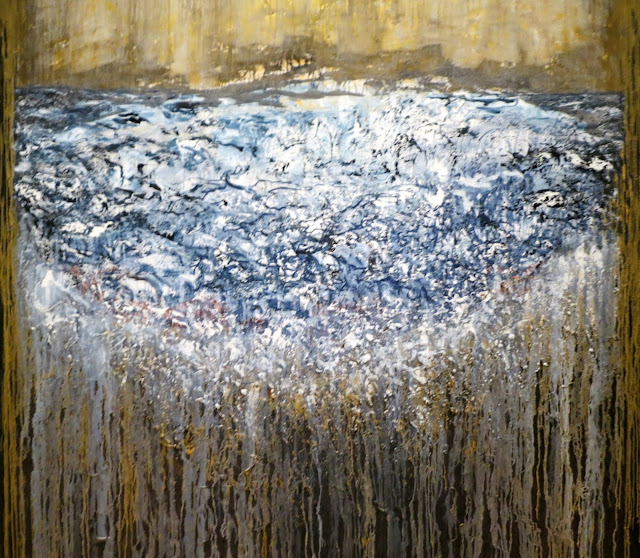'It was like a circle of madness, a circle of hell... We saw some injured calling, crying for help. We saw the fire everywhere. We smelled the smell of the barrel bomb'. Ammar El-Selmo, Head of a branch of the Syrian Civil Defence, Aleppo. Sept. 2016
Edge, by Maggi Hambling, at Marlborough Fine Art, Mayfair, London
This exhibition comprises a range of paintings and sculptures in which the condition of being 'on edge', on the edge of destruction, is the unifying characteristic. These works address multiple subjects - cities, landscapes, human lives. But all are concerned with a moment of transition, the point at which a known quantity unravels into something strange and new.
2016, 2016
2016 is at the centre of this exhibition. 'I kept seeing pictures on television and elsewhere, of these people, and hearing on the news that a whole boat had gone down. Boats wee being abandoned by the traffickers and left to drift and disappear'. 2016 presents one such boat from a bird's eye view, or through a helicopter's hovering lens. The gold paint which picks out the shape of the vessel is an incongruous touch - a dark intimation of the wealth which the boat's inhabitants will never attain, and a symbol of the greed of the people who have trafficked them. The gold shines out but the huddled figures have almost been obliterated.
2016 is also a painting of a year and a microcosm of the events which took place in that time. The image of a boat at sea becomes a metaphor for larger realities.
Aleppo:
Hambling calls the Aleppo paintings a 'lament' - a potent mixture of empathy and outrage emanates from the charged surfaces of the pictures. In the panorama of the city, space appears condensed: pulverised buildings and smoke press up against the surface, spreading out against a sky of dull gold. 'It's about the loss of what you know', Hambling explains. 'If I try to put myself in the shoes of someone in Aleppo, then I think of arriving in Ipswich - a place I've known since I was a child - and finding that it's collapsed, gone'.
Aleppo III, 2016, (oil on canvas)
'In Aleppo III, you're confronted with this figure who could be a victim or could be an aggressor. He could be one of the rebels on whose side we were. There's an ambiguity about which side he's on', explains the artist.
looking closer

Aleppo IV, 2016, (oil on canvas)
In Aleppo IV, representation has given way to an expanse of encrusted black and silver,
in the midst of which lies the golden head of a child.
The portraits:
Hangover, 2016, (oil on canvas)
This is a painting of a feeling rather than a face.
Beethoven, 2016, (oil on canvas)
Beethoven is idolised (cast as a gold idol). This masklike representation uses the same gold paint which features prominently throughout the exhibition.
Ghost, 2016, (oil on canvas)
Leonard Cohen, 2016-17, (oil on canvas)
The gold brushstrokes capture the singer's defining quality - the golden voice.
(As the singer himself points out in the Tower of Song:
I was born like this, I had no choice
I was born with the gift of a golden voice
And twenty seven angels from the Great Beyond
They tied me to this table right here
In the Tower of Song).
Edge:
'Suddenly it seems as if the dawn were coming; it is like water purling over ice and the ice is blue with a rising mist, glaciers sunk in emerald green, chamois and antelopes, golden groupers, sea cows mooching along and the amber jack leaping over the Arctic rim...' Henry Miller, Tropic of Cancer, 1934
As with the Aleppo paintings, the Edge series developed out of an emotional response: 'They come from a feeling of fury', Hambling says, 'fury, really, about the fact that we are destroying the planet'. Hamgling envisions icecaps - the furthest edges of the world - undergoing slow destruction. Their melting is captured as a beautiful yet inexorable change. Plateaus of ice, suspended mid-canvas, emerge from the sea like the mushroom clouds of atomic bombs. We witness the gradual, humanmade disaster as if through expanded senses - as if on the threshold of a dream.
Edge III, 2015, (oil on canvas)
Edge VI, 2016, (oil on canvas)
Edge VIII, 2016, (oil on canvas)
looking closer
Aftermath:
Each sculpture is based on a chunk of dead wood encrusted with layers of plaster and paint, remaining open in form and meaning.
Hunger, 2016
Atrophied Bird, 2016
Politician, 2015
Sleeper, 2013
Survivor, 2014
Homunculus, 2013
























No comments:
Post a Comment